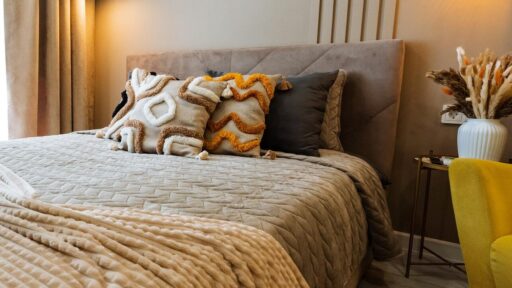Besides the fundamental styling features for your dining chairs; other significant aspects are comfort, functionality and durability. So, what helps define these other key aspects of dining chairs?
Choosing the Right Chair Shape
The right chair shape can significantly enhance not only the aesthetic appeal of your dining area but also the comfort and functionality of your space. Let’s delve into the three primary options: armchairs, side chairs, and benches.
Armchairs
Armchairs are synonymous with elegance and comfort. Their wider frame and cushioned armrests invite leisurely meals and extended conversations. Perfect for the head of the table or as accent pieces at either end, armchairs provide a sense of luxury and can serve as a design focal point.
A sleek, modern armchair can add a contemporary twist. A a plush, upholstered version can evoke a more traditional or rustic charm. Just remember to ensure they fit comfortably under the table to maintain a balanced look.
Side Chairs
Side chairs offer versatility and space-saving benefits. They typically lack armrests, making them easier to tuck away when not in use.
Ideal for larger dining tables, side chairs can be mixed and matched for a playful, eclectic vibe or chosen in uniform styles for a more cohesive look. Side chairs can easily complement any dining decor. They also provide the flexibility to be moved to other rooms in your home, doubling as extra seating in the living room or home office.
Benches
Finally, benches are an increasingly popular choice that adds a touch of casual charm to your dining space. They are perfect for families or larger gatherings, allowing for more people to sit together at the table.
Benches can create a warm, communal atmosphere, encouraging conversation and connection.
When selecting a bench, consider the length to ensure it fits your table perfectly. Also think about the material. Upholstered benches offer comfort, while wooden ones provide a more rustic feel.
Balancing these elements will ensure your dining area is not only beautiful but also a welcoming environment for shared meals and cherished memories.
Color Coordination: Matching Chairs with Your Dining Table
The right color scheme can elevate the overall aesthetic of your dining room. It can transform it from a simple eating area into a stylish gathering place for family and friends.
Start by considering the color of your dining table.
- Is it a rich, dark wood that exudes elegance?
- Or perhaps a bright, modern finish that brings a touch of contemporary flair?
Once you’ve identified the dominant color, think about how you want your chairs to complement or contrast with it.
For instance, if your table is a deep mahogany, lighter-toned chairs in beige or cream can create a stunning visual balance, allowing the table to take center stage. Conversely, if your table is a sleek white, bold-colored chairs—such as navy blue or forest green—can add a pop of personality and interest to the space.
Texture is another important aspect of color coordination. A plush velvet chair in a muted tone can soften the look of a stark wooden table, while metal or plastic chairs in vibrant hues can lend a more eclectic vibe. Don’t shy away from mixing different materials, as this can add depth and dimension to your dining area.
Lastly, consider the overall theme of your home. If your decor leans toward a rustic farmhouse style, opting for chairs in weathered wood or pastel shades can enhance that warm, inviting atmosphere.
For a more modern aesthetic, streamlined chairs in monochromatic colors or geometric patterns can create an eye-catching contrast with a traditional wooden table.
Durability and Maintenance: How to Choose Long-lasting Chairs
To ensure your investment stands the test of time, consider the materials and construction methods of the chairs you’re eyeing.
First, examine the frame. Solid wood frames, such as those made of oak or maple, tend to offer superior durability compared to particle board or softer woods that may warp or crack over time. Look for joinery techniques like dowels or mortise-and-tenon joints, which provide added strength and stability.
A well-constructed frame will ensure that your chairs remain sturdy, even through years of family gatherings and dinner parties.
Next, consider the upholstery. If your dining room is a bustling hub of activity, opt for fabrics that resist stains and wear. Synthetic fibers like polyester or treated cotton blends can offer durability while being easy to clean.
Leather and faux leather are also excellent options for high-traffic areas, as they can be wiped down with a damp cloth to remove spills or stains.
Another essential aspect of maintenance is the finish of your chairs. If you choose wooden chairs, consider a finish that is resistant to scratches and easy to maintain. A high-quality varnish or polyurethane coating can protect the wood from moisture and enhance its longevity.
For upholstered chairs, look for removable covers that can be washed or replaced, ensuring that your chairs stay fresh and inviting.
Finally, don’t forget about weight capacity and stability. Chairs that are too lightweight may not hold up well under heavy use, so select options that provide both comfort and sturdiness. You want your dining chairs to not only look good but also feel secure.
Testing Before You Buy: The Importance of Sit-Tests
A sit-test allows you to assess the chair’s comfort level, support, and overall suitability for your dining space before making a purchase.
Take a seat! Feel the chair’s dimensions against your body—does the seat feel too firm or just right? Is the backrest supportive enough, or does it leave you feeling slouched?
During this sit-test, consider how you and your guests will be using the chairs.
- Will they be used for long, leisurely meals, where comfort is paramount?
- Or are they intended for quick breakfasts on the go?
- The height of the chair in relation to your dining table also plays an important role
- A well-proportioned chair can enhance the overall dining experience
Moreover, don’t hesitate to test how easy it is to get in and out of the chair. A chair that looks good but is cumbersome to use might become a source of frustration over time. And if you have specific needs or preferences, such as cushioning or armrests, make sure those factors are taken into account during your testing.
Budgeting to Find Quality within your Price Range
Determine how much you are willing to spend on your dining chairs and consider the number of chairs you need. This will help you narrow down your options and make the shopping process less overwhelming.
Once you have a budget in mind, explore various materials and construction methods.
- Solid wood chairs may cost more upfront but their durability can save you money in the long run
- Upholstered chairs that feature high-density foam cushions
- This feature can provide both comfort and a touch of luxury while still being available at various price points
- Explore second-hand options
Often, you can find stunning pieces that may have been slightly used but still hold their charm and functionality. Online marketplaces, thrift stores, and furniture outlets can be treasure troves for unique finds.
Additionally, read reviews and seek recommendations to ensure that the chairs you are eyeing are not just visually appealing but also offer the comfort and support you need.
Where to Shop: Online vs. In-Store Options
Each option has its unique advantages and challenges.
Shopping Online
Websites often feature extensive filters, allowing you to narrow down your search by price, size, or design. Plus, you can easily compare prices across various retailers to snag the best deal.
Many online stores even offer customer reviews and ratings. This would give you insight into the experiences of others who have purchased the same chairs.
However, shopping online does come with its drawbacks. One, you miss the tactile experience of sitting in the chair to assess comfort and quality. Two, the colors and textures may appear differently on your screen than they do in real life.
Shopping In-Store
In-store shopping allows you to physically interact with the chairs. You can test for comfort, assess the quality of materials, and see the true colors and designs in natural lighting. This hands-on experience can be invaluable, especially when choosing pieces that will be central to your dining space.
In-store shopping also provides the opportunity to consult with sales associates who can offer expert advice and recommendations based on your specific needs.
However, the downside is that your choices may be limited to what the store has in stock, and you might find yourself hopping from one retailer to another in search of the perfect chair.
Ultimately, the best approach might be a combination of both. Start by browsing online to gather inspiration and narrow down your options, then visit local stores to test your favorites.



